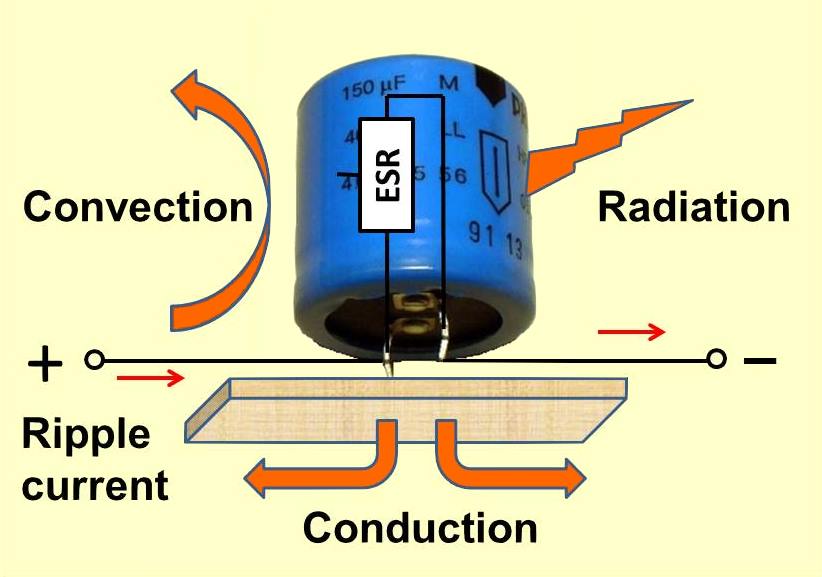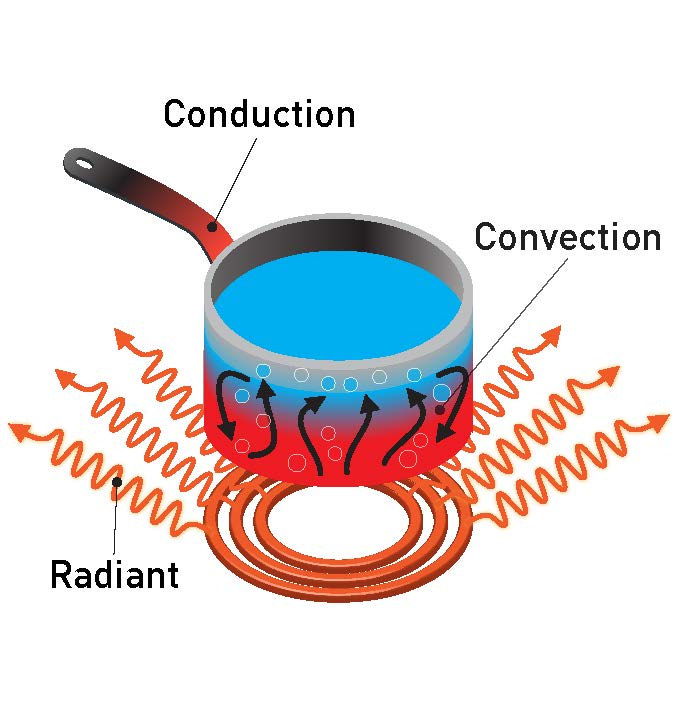Difference Between Conduction and Convection
The change of energy between two systems (bodies) due to their different temperatures is called heat transfer. The heat transfer from one to the other body takes place spontaneously, from the warmer (higher temperature) to the colder body (lower temperature). If there are no other causes, the state of the observed systems will change until heat balance is established. In principle, there are three modes of heat transfer: conduction, convection and radiation.

What is Conduction?
Heat conduction is a way of heat movement that is characteristic for solid materials, although it appears (but with negligible intensity) in fluids as well. This means that conduction is a process of heat transfer through a medium without transport of mass. When there is a temperature difference between different parts of a system, a heat transfer takes place through which the energy passes from the area (body) with a higher temperature into the area with the lower temperature range. Energy is transmitted from particle to particle, i.e. heat moves from one end to the other end, while the substance (system, body) is idle. Conduction takes place in homogeneous non-conductive hard bodies, and it is done by transmitting the heat from one particle to other, without any apparent movement. Similarly, the same happens in a homogeneous, translucent hard body, such as glass and quartz, while some of the heat is also carried out with radiation. According to the molecular kinetics theory, this method of heat transmitting is done by collision of molecules. Molecules in the warmer body have higher speed, and when clashed, their velocity (temperature) decreases, while the slower (colder) molecules get faster. The characteristic of the material that signifies the intensity of the heat movement through the material is called thermal conductivity coefficient – λ (W / m ° C) and it is a measure of how good heat conductor a material is, and it affects the heat transfer velocity. The amount of heat Q that will be passed by conduction through the homogeneous plate can be calculated according to the following formula:![]()

What is Convection?
Convection is a transfer of heat done by circulating or moving of the warm particles to a cooler space. This is another intuitive concept because we know that warm air or water goes up. With circumference, the cooler particles are shifted (swapped) with the warmer ones. The cold particles are then heated up and the process continues to produce convection flow. Convective transfer occurs between the outer walls of the body and the environment as well as between the inner walls and the body and the interior environment. In case of convection the heat transfer takes place along the boundary of the solid body and the fluid surrounding it. This kind of heat transfer occurs only if the fluid is moving. The course of the heat movement depends on the temperature of the solid body and the fluid moving around that body. When the motion of the fluid is caused for example, by a mixer, or a pump with a ventilator, the convection is forced. Otherwise is natural. The amount of heat transmitted in the time unit across an area Fz (thermal flow) is determined on the basis of the expression: ![]() where:
where: ![]()
coefficient of heat transfer by convection, t¹, t² fluids’ and body’s’ temperature, F² – the body’s surface covered by fluid.
The process of convection in fluids is always followed with the transfer of heat through conduction, because the particles always come in direct contact with each other.
Difference Between Conduction and Convection
1) Definition of Conduction and Convection
Conduction is a mechanism of heat transfer through solid materials. Conduction as a process represents an exchange of kinetic energy of molecules in their mutual collisions. In the collision of molecules, kinetic energy is exchanged, whereby faster molecules that have higher kinetic energy and greater heat give part of the heat to slower molecules that have lower heat level. Convection is a mechanism of indirect heat transfer. Depending on the temperature of the solid body and the fluid, one of them will give (warmer), and the other (cooler) will receive thermal energy. The greater the speed of movement of the fluid the more convection increases.
2) Cause of Conduction and Convection
Conduction happens because of hear difference, while there is density difference in case of convection.
3) Occurrence of Conduction and Convection
Conduction occurs only in solids (direct transfer of energy). Convection occurs by flow of energy in fluids.
Conduction vs. Convection: Comparison Chart

Summary of Conduction and Convection
- Heat transfer happens everytime there is a temperature difference between two points in some environment. This transfer is a heat energy passing as a consequence of the temperature difference.
- Conduction is a direct transfer of energy from particle of a matter (solid or liquid) from an elevated energy level, to particles at a lower energetic level, as a consequence of the interaction between the particles.
- Convection is the transfer of energy between the surface of a material and a fluid that is spread over / under the material or in the fluid itself (liquid or gas). Variations in temperature result in differences in fluid density, which causes movement of molecules, whereby the hot parts with a smaller mass go up, while the cold parts do the opposite. These movements result in a temperature balance. In physics, this process is known as “Brownian motion”.
- Difference Between Thermodynamics and Kinetics - June 24, 2018
- Difference Between Welding and Soldering - June 24, 2018
- Difference Between Additive Colors and Subtractive Colors - June 20, 2018
Search DifferenceBetween.net :
2 Comments
Leave a Response
References :
[0]Lienhard IV, J. H. & Lienhard V, J. H. “A Heat Transfer Textbook, 3rd edition.” Cambridge: Phlogiston Press, 2008. Print
[1]Kaviany, M. “Principles of Convective Heat Transfer.” New York: Springer-Verlag, 1995. Print
[2]Hewitt, G. F. “Heat Exchanger Design Handbook 2008.” New York: Begell House, 2008. Print
[3]Image Credit: https://upload.wikimedia.org/wikipedia/commons/d/d2/E-cap-ESR-heat_dissipation.jpg
[4]Image Credit: http://www.machinedesign.com/sites/machinedesign.com/files/styles/article_featured_standard/public/convetionconductionradiationpromo.gif?itok=Mt-Ktf0i

Note:While we place great care into preparing 1800W Electric Toaster Oven Convection Broiler 40L Countertop with Drip Pan New descriptions and prices, sometimes technical and typographical errors or omissions may occur. If you’re willing to pay more for an best toaster oven from a premium brand, check out the 1800W Electric Toaster Oven Convection Broiler 40L Countertop with Drip Pan New View our ratings and reviews of the 1800W Electric Toaster Oven Convection Broiler 40L Countertop with Drip Pan New, and browse our Buying Guide to find the best toaster oven that are worth the bread. EXPERT TIP: Measure your counter space to ensure you have enough room for your 1800W Electric Toaster Oven Convection Broiler 40L Countertop with Drip Pan New, as well as enough surrounding space to avoid overheating items nearby.
Conduction Is Apassege way Of Heat